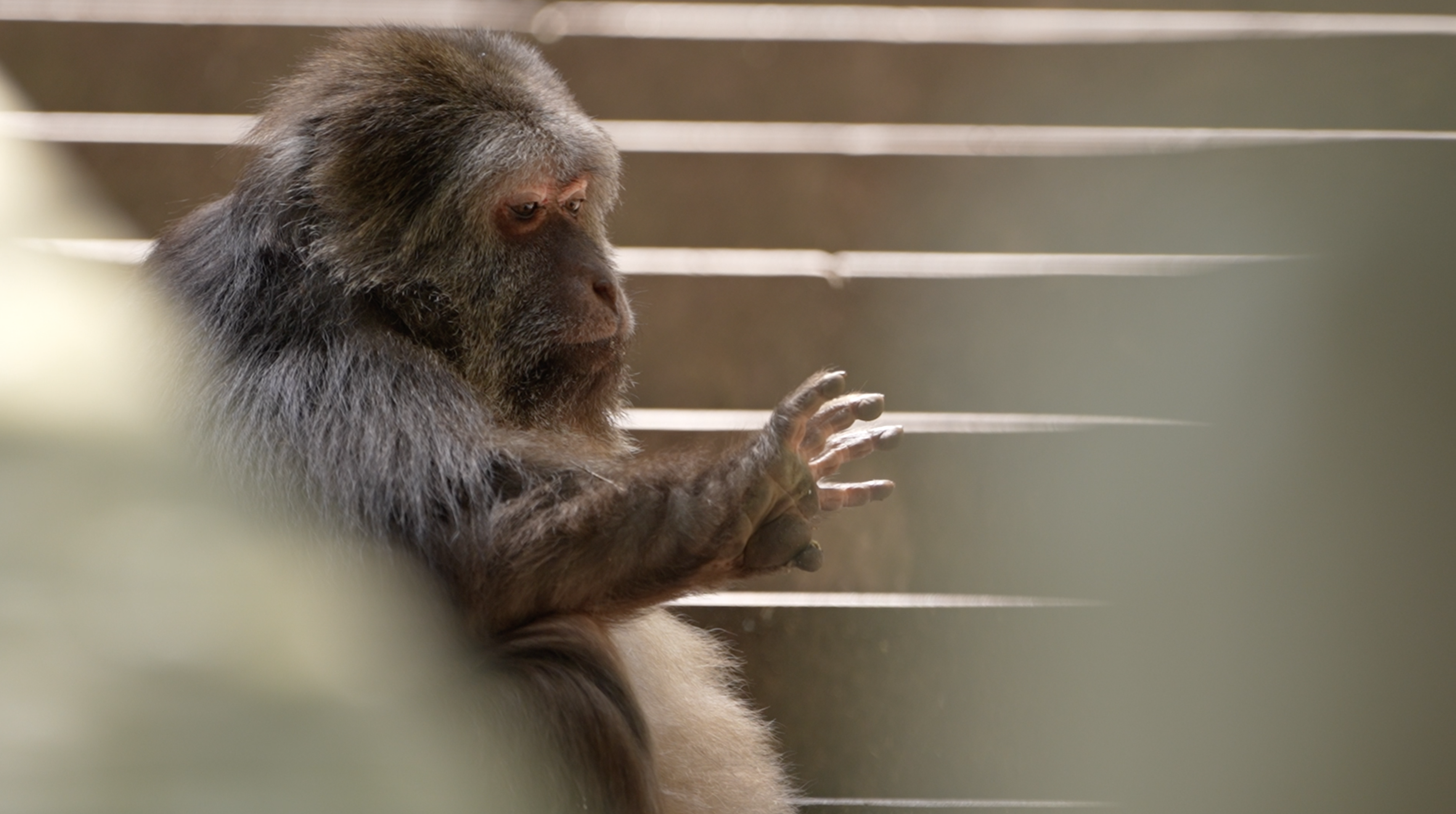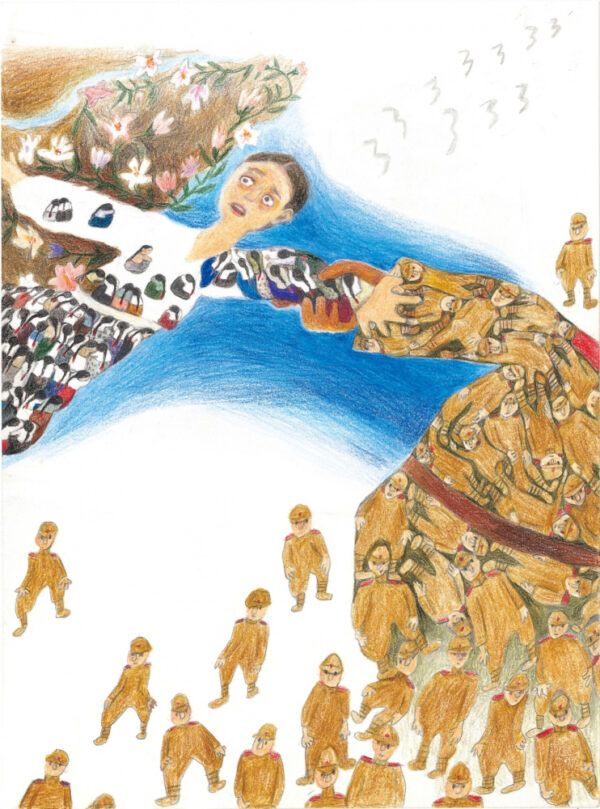A monkey has become my recent hyperfixation. Xing Xing (meaning star in Mandarin Chinese) is a Tibetan macaque who became highly popular in mid-2024 and has remained at the pinnacle of animal social media content. At the heart of Xing Xing’s virtual fame is the monkey’s humanity, as demonstrated through her interactions with Grandma, the elder who had rescued her. Xing Xing is a typical product of the modern-day manufacturing of media trends— a Monkey first made famous domestically and then earned the favour of the world. However, it is a spectacle detached from reality, trivializing the fact that this content is designed primarily for human entertainment. Therefore, I hope to open up the questions about ethics in this human construct of animal celebrity to examine the production and circulation of non-human actors in human capitalist activities.
For hundreds of years, monkeys have coexisted with humans in Asia. It is not unusual to see monkeys as companions to human agents along with other animals in the shared spiritual cosmology, as seen in the Chinese literary canon Journey to the West.[1] Sharing both the wicked and the witted, humans and monkeys are allegorical to one another. Thus, if monkeys have such a ubiquitous presence in Asian culture, where does this sense of wonder from monkeys come from when we see them on social media?
Before Xing Xing, I want to turn my attention to a prior monkey celebrity– Mini from Indonesia. Mini was frequently tortured by content creators to satisfy their viewers, with content-creators even making online polls to decide what agony Mini should be put through next. Unfortunately, Mini is only a small part of a larger monkey torture ring that is only enabled by globalized media exchange. The audience of such content, usually from the global north, commissions the local “video operators” who perform the violence for them to make their most horrific fantasies reality.[2] According to the 2023 report of the Social Media Animal Cruelty Coalition, the social media content creation of monkeys is most prominent in Asia, while 60% of their data involves direct physical abuse of the monkeys.[3] Although much of the global “monkey supply” used to be from China, that role has been taken over by Cambodia after China prohibited the wildlife trade following the pandemic. Still, while Cambodia remains a major exporter, the US is still the world’s biggest importer of monkeys, responsible for 78% of the trade.[4] Furthermore, monkeys are not obtained simply through hunting, but also through captive breeding. This further exacerbates the monkeys’ condition as they are much less adaptable to captivity compared to domesticated pets. It’s unsurprising to know that nearly 70% of traded exotic animals don’t survive at the wholesaler level.[5]
Unlike Mini who received tremendous hatred and abuse, Xing Xing is loved by humans. Yet she does not escape from the complex of human-primate relationships and the global social media business. Her internet sensation first originated in Chinese social media and soon caught the attention of Western platforms. The process of exporting via social media detaches Xing Xing from her reality, distorting her life into a source of entertainment akin to a fictional character. Many parts of her story become overlooked. How did she lose her arm? How did she first get released in Daliang mountains in Sichuan and end up at the temple in Zhejiang, thousands of miles away? What is it like for her, as a highly social species, to have to live on her own in solitude? What are humans like for her and how does she interact with humans besides Grandma, who is actually a Buddhist nun? What are humans like for her? How are we humans capable of being in social relations with her and being her companions? These questions and many more are not yet brought up in the less-than-a-minute reels I watched. Tracing the online comments about Xing Xing, the reaction delves from lovely appreciation to memes and entertainment. Visitors flooded the temple to greet the celebrity and to recreate the content themselves, turning Xing Xing into a source for clips. People began to feed her human food for “review” and “poison detecting” (试毒), which is detrimental to her health and makes Xing Xing more aggressive to humans. Such disturbances to Xing Xing were so extreme that the temple had to put up a giant poster asking the tourists not to feed her. Although such interventions from tourists and fans were out of love, how different is it from the pathological obsession of Mini who is now rescued and struggles to learn to adapt to wildlife? In both cases, human emotions towards monkeys blur the line between curiosity and violence, elevating Xing Xing to an exceptional position that justifies potential abuse.
Xing Xing now is a spectacle. A spectacle shaped by social media for humans who, in turn, fetishize the animals they claim to love.[6] On the screen, we see Xing Xing, but we do not see her true self. Anthropologist Narsargi Davé, a professor from the University of Toronto, distinguishes witnessing from seeing. Witnessing requires thereness and a movement toward the “subject of intimacy and away from the self and its protective skin.”[7] Social media renders Xing Xing more like a conduit to affirm human desires and their sense of self-centered exceptionality. What we see is only a monkey we find adorable, funny, and nothing else. Social media removes all the potential risks of encountering an animal in real life, but it is precisely these risks that can allow us actually to witness them and participate in the shared ecology. Even though the audience does see their humanity and emotions reflected in her expression, this reflection is no longer provocative, halting her only to a bleak digital image. We cannot love her, nor can we hate her, because we are never there with her.[8] We never let go of all the pretentiousness of humans to enter her life and let her enter ours. We never see her responses to us and see us vulnerable in them. We never know her as a subject who has her own grounding on this earth, with dignity, power and depth that cannot be fathomed by another species.
Nonetheless, this interaction, enabled and limited by social media, is not the only form but rather a specific product of economic exploitation in Asia and other parts of the Global South. At a time when the natural habitats of wildlife are in danger of urban development, human-wildlife encounters are unavoidable to a certain extent. This article is a small attempt to take on the ethical stakes embedded in social media encounters with a beloved monkey and to shed light on how much humanity owes to other beings. On top of these, I wish to reimagine the space of intimacy where we can witness and love these animals. It must have existed at some point before, something we have long forgotten, and perhaps can still remember.
Qiuzi Mei is a third-year undergraduate student who specializes in socio-cultural anthropology. Meanwhile, she is also pursuing a double minor in Contemporary Asian Studies and Literature and Critical Theory. Her research interests are on migration, secularism, affect and memory.
Bibliography
Dave, Naisargi N. “Witness: Humans, Animals, and the Politics of Becoming.” Cultural Anthropology 29, no. 3 (2014): 433–56. https://doi.org/10.14506/ca29.3.01.
Delgato, Anton. “SMALL MONKEYS ARE BIG BUSINESS in CAMBODIA’S ANIMAL TRADE.” Southeast Asia Globe. Southeast Asia Globe. 2022.
https://southeastasiaglobe.com/small-monkeys-are-big-business-in-cambodias-animal-trade/.
Erickson-Davis, Morgan. “Social Media Helps Fuel China’s Illegal Craze for ‘Thumb Monkeys.’” The Guardian. The Guardian. February 26 2016. https://www.theguardian.com/environment/2016/feb/26/social-media-helps-fuel-chinas-illegal-craze-for-thumb-monkeys.
Gunter, Joel, Rebecca Henschke, and Astudestra Ajengrasti. “Global Network of Sadistic Monkey Torture Exposed by BBC.” BBC News. BBC. June 19 2023. https://www.bbc.com/news/world-65951188.
“Hunting the Monkey Torturers.” BBC News. BBC. June 20 2023. https://www.bbc.co.uk/news/extra/Iot1dIWVS5/hunting-the-monkey-torturers.
Johnson, Jean, and Ryan Bradeen. “Using ‘Monkey’ to Teach Religions of China.” Association for Asian Studies. Association for Asian Studies. 2005. https://www.asianstudies.org/publications/eaa/archives/using-monkey-to-teach-religions-of-china-2/.
“The Cruelty You Don’t See: The Suffering of Pet Macaques for Social Media Content.” World Animal Protection. World Animal Protection. September 18 2023. https://www.worldanimalprotection.org/latest/press-releases/cruelty-you-dont-see-suffering-pet-macaques-social-media-content/.
- Anton L. Delgado, “SMALL MONKEYS ARE BIG BUSINESS IN CAMBODIA’S ANIMAL TRADE,” Southeast Asia Globe, Southeast Asia Globe, 2022, https://southeastasiaglobe.com/small-monkeys-are-big-business-in-cambodias-animal-trade/. ↑
- Joel Gunter, Rebecca Henschke and Astudestra Ajengrastri, “Global network of sadistic monkey torture exposed by BBC,” BBC, BBC, 19 June 2023, https://www.bbc.com/news/world-65951188. ↑
- “The Cruelty You Don’t See: The suffering of pet macaques for social media content,” World Animal Proetction, World Animal Protection, 18 September 2023, https://www.worldanimalprotection.org/latest/press-releases/cruelty-you-dont-see-suffering-pet-macaques-social-media-content/. ↑
- Delgado, “SMALL MONKEYS ARE BIG BUSINESS IN CAMBODIA’S ANIMAL TRADE”. ↑
- Morgan Erickson-Davis, “Social media helps fuel China’s illegal craze for ‘thumb monkeys’,” The Guardian, the Guardian, 26 February 2016, https://www.theguardian.com/environment/2016/feb/26/social-media-helps-fuel-chinas-illegal-craze-for-thumb-monkeys. ↑
- Naisargi N. Dave, “Witness: Humans, Animals, and the Politics of Becoming,” Cultural Anthropology 29, no. 3 (2014): 441, https://journal.culanth.org/index.php/ca/article/view/ca29.3.01. ↑
- Dave, “Witness: Humans, Animals, and the Politics of Becoming,” 440. ↑
- Dave, “Witness: Humans, Animals, and the Politics of Becoming,” 448. ↑








